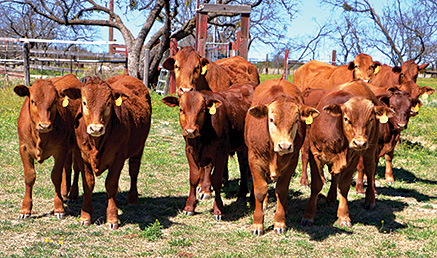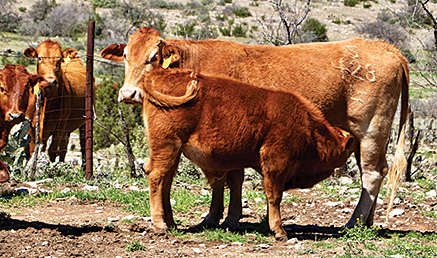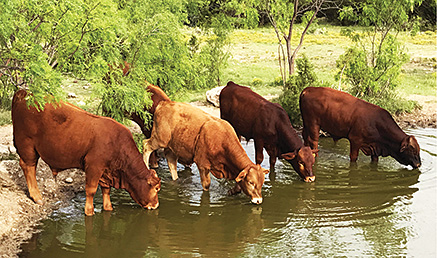

From the Spring 2020 issue of the Isa Informer
By Lorenzo Lasater, President
Accountability noun | [uh-koun-tuh-bil-i-tee] — the state of being accountable, liable or answerable
In simple terms, accountability means accepting responsibility. We are personally accountable to many things in life: our God, our family, our banker, our job. The list goes on….
But how often do you think about accountability on the ranch? One thing is certain: if you don’t hold your herd accountable, you can’t make genetic progress. This is especially true of seedstock producers, who are theoretically held to a higher standard as genetics producers.
The most fundamental standard we should demand of our cattle is fertility. For example, the absolute best a cow can achieve from a productivity standpoint is having one calf per year. This rigorous plan assumes 283 days’ gestation and roughly 45 days for involution, which totals 328 days. This leaves only 37 days to rebreed, which means we really need to hustle (as do our cows). On the flip side, in a breeding season of longer than 90 days, the whole herd cannot possibly rebreed annually.
At Isa Beefmasters, we have used a 60-day breeding season for as long as I can remember. This schedule has a nice rhythm: All the cows have a chance to rebreed annually, the calves are tightly grouped and the cows should have three chances to cycle and conceive.
 Sixty-day breeding seasons ensure every cow can produce a calf annually. In addition, calves are tightly grouped with their peers, making performance evalutions that much easier.
Sixty-day breeding seasons ensure every cow can produce a calf annually. In addition, calves are tightly grouped with their peers, making performance evalutions that much easier.If your seedstock provider utilizes a season of longer than 90 days, their entire herd cannot raise a calf every year, which means they not placing selection pressure on fertility. Some breeders list many excuses for a longer season: climate, embryo program, etc. But if they don’t hold their own herd to a higher standard for fertility than their commercial customers, who’s ahead of whom?
Calving ease is closely connected to fertility. We breed our heifers at 14 months to calve at two years old and then every year thereafter. It would be much easier to give them an extra six months to develop prior to breeding and calving, but if we intend to be accountable for calving ease and early fertility, we must forge this path to genetic improvement.
Another important component of accountability is nutritional efficiency. We strive to optimize nutrition while minimizing costs and still achieving reasonable reproductive rates. It is easy to claim 95% pregnancy rates if the cows are in a pen eating free-choice, high-energy ration. But what if they are surviving on rough native country through the winter with minimal protein supplement? It seems to me that those cows are truly accountable and paying their own way. It also more closely mirrors the production system of most commercial operations.
To gauge production efficiency, we can measure pounds per calf weaned. But does that really tell the whole story? What about the costs to achieve those pounds? It drives me crazy to hear seedstock producers claim enormous weaning weights, when those weights were actually achieved on creep feed, wheat pasture or another intensive supplement.
 What good are outrageous weaning weights if you spend a fortune to achieve them? We prefer low-cost weaning weights achieved the old-fashioned way. A cow weaning a quality calf in rough, native pastures exemplifies accountability.
What good are outrageous weaning weights if you spend a fortune to achieve them? We prefer low-cost weaning weights achieved the old-fashioned way. A cow weaning a quality calf in rough, native pastures exemplifies accountability.As we have discussed, a cow under natural production can, at best, reproduce herself once annually. Even if she lasts many years—as Beefmasters do—and has a calf every year, her impact is limited to 10 to 12 calves at the most. Bulls on the other hand can breed 25 to 40 females per season and be used in multiple seasons annually. This larger scale means accountability for his genetic impact becomes paramount. If we are serious about genetic change, we can’t just pick for a fancy pedigree or a pretty smile; we must hold them accountable for many critical phases, including growth, calving ease, carcass quality, fertility, confirmation, pedigree, disposition and EPDs.
 We breed our cattle in multiple-sire herds, just like our customers’ commercial beef operations. This competition allows us to identify dominant breeders and propagate their fertile genetics.
We breed our cattle in multiple-sire herds, just like our customers’ commercial beef operations. This competition allows us to identify dominant breeders and propagate their fertile genetics.In the catalog accompanying this mailer, you’ll see our spring bull offering has been evaluated for 37 different data points encompassing all these categories. We use this data to identify the sires that will move the needle for the collection of traits important to our operation, while never losing sight of overall balance. If you are making critical herdsire decisions with less data, you might ask yourself why.
One of the most rewarding aspects of breeding livestock is seeing the promise of genetic progress. We cannot fully realize the impact of the breeding decisions we make today for months or possibly even years, but if we remain consistent in our vision and accountable to the process, the results can be fantastic.
© ISA BEEFMASTERS 1996-2023 ALL RIGHTS RESERVED.